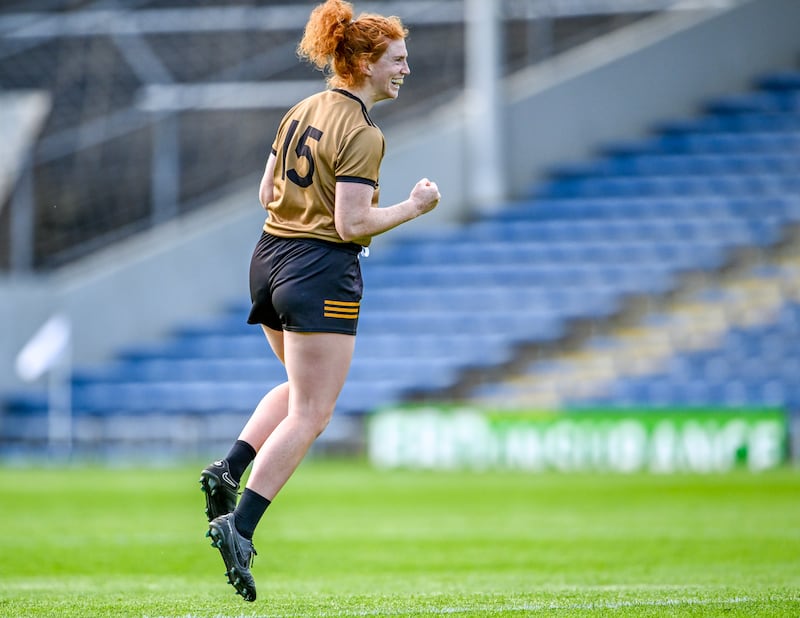When counties such as Kerry or Cork or Dublin talk about ‘famines’, it’s usually all relative. Cork ended a five-year drought last Sunday in the camogie (really no more than a prolonged dry spell, surely). Dublin seemed rather excited about winning their first All-Ireland football final in 31 months the week before.
But the Kerry women’s football team are aiming to end a 30-year wait for a 12th All-Ireland title on Sunday, and by any metric, that’s a hell of a long time. It is rather strange, however, to see that notwithstanding that long wait since 1993, they have managed to retain their place at the top of the women’s football All-Ireland roll of honour.
They won 11 of the first 20 finals played, but had only reached one other final since then until last year’s loss to Meath. This is a pattern repeated across women’s football. Cork are currently level with Kerry at the top of the roll of honour, and they won their 11 titles in just 12 years.
Counties have sprouted up, enjoyed their period of dominance and then shrunk back into the shadows. Mayo won four titles in five years around the turn of the millennium, but have only been back to a final once since that period. Waterford won five in eight years in the 1990s but haven’t been back to the showpiece since 2000.
O’Loughlin Gaels prevail as All-Ireland club semi-finals produce two of the year’s best games
Louise Ní Mhuircheartaigh, Leah Caffrey and Jennifer Dunne nominated for Player of the Year award
Hannah Tyrrell says All-Ireland victory fulfils a long-held dream
The Schemozzle: Eilish O’Dowd’s unusual backstory took her from Leitrim to Dublin success
So Kerry have had, in effect, just one golden era in women’s football. Leaving aside that losing final appearance in 2012, this current team has an amazing opportunity to create a legacy for the game in a county that won their All-Irelands well before the eyes of the country were fixed on women’s football.
Building that legacy isn’t easy, but it was gratifying to see a number of their male stars past and present posting excitedly on social media in the run-up to their All-Ireland quarter-final at home in Tralee against Meath last month.
It was on the same weekend that their men’s senior team were playing Derry in the All-Ireland semi-final, a trip many Kerry fans were unwilling to make. But the idea of heading into Austin Stack Park to see Kerry knock out the reigning champions proved an appetising prospect.
The game was played in one of our sadly soon-to-be-regular summer monsoons, but even at that, there was a big home crowd. When it comes to attendances in women’s GAA, there has, on occasions in the last 15 years, been too much focus on trying to get a big crowd into Croke Park on All-Ireland final day. That is, of course, perfectly understandable, but on its own it could be suggestive of an audience a mile wide but an inch thick.

Getting crowds of 2,000-3,000 to All-Ireland quarterfinals is not easy, but it’s an indication of the deepening of the game’s appeal. The crowd in Tralee that day marked it out as an important stepping stone for this Kerry team – quite apart from the result, which was a fully merited victory over Meath’s three-in-a-row chasers.
All four of the All-Ireland quarterfinals this year were hard to call before throw-in, and three of the four of them were tight affairs, with a 15-point Dublin win (gaining a measure of revenge over Donegal, who beat them at the same stage last year) the only real blowout of the quartet.
Those games were played before and between the men’s semi-finals, and there’s always a temptation to suggest that if those four games were happening this weekend, for instance, with a late August or early September All-Ireland final date, they would have got the attention and eyeballs that they deserved.
Players and managers are far less concerned about that than people like me are, and that’s to be lauded. They see the benefits of a shorter intercounty season too, just like the men’s players do. And, as players from all counties have shown this summer, they are far more energised by topics like travel expenses, medical cover and adequate training facilities than they are by more nebulous concepts like media coverage or “exposure”.
This Kerry team were denied access to Kerry GAA’s centre of excellence for much of last year, with Louise Ní Mhuircheartaigh memorably stating last summer that there were four player portraits at the front of the centre, and she was one of them – she’s just wasn’t allowed to actually train there. There have been no murmurings on that score this year, and aside from a disheartening Munster final defeat to Cork, they’ve improved game on game.
Ní Mhuircheartaigh is a bona fide superstar, but there has tended to be an over-reliance on her to carry most of the scoring load (sound familiar, Kerry fans?) – a fact not lessened by the loss of Síofra O’Shea, who tore her cruciate knee ligament in training before the All-Ireland semi-final against Mayo.
[ Síofra O’Shea helps show Kerry the way even though she can’t playOpens in new window ]
Kerry waiting 30 years for anything in Gaelic football seems like an anomaly, but it’s not the only one coming into this weekend, as this is also the first time that Kerry and Dublin have met in an All-Ireland women’s football final. Dublin have far greater experience in their ranks and that makes them narrow favourites. But this Kerry team are coming, and they might justifiably feel like it’s high time.
















